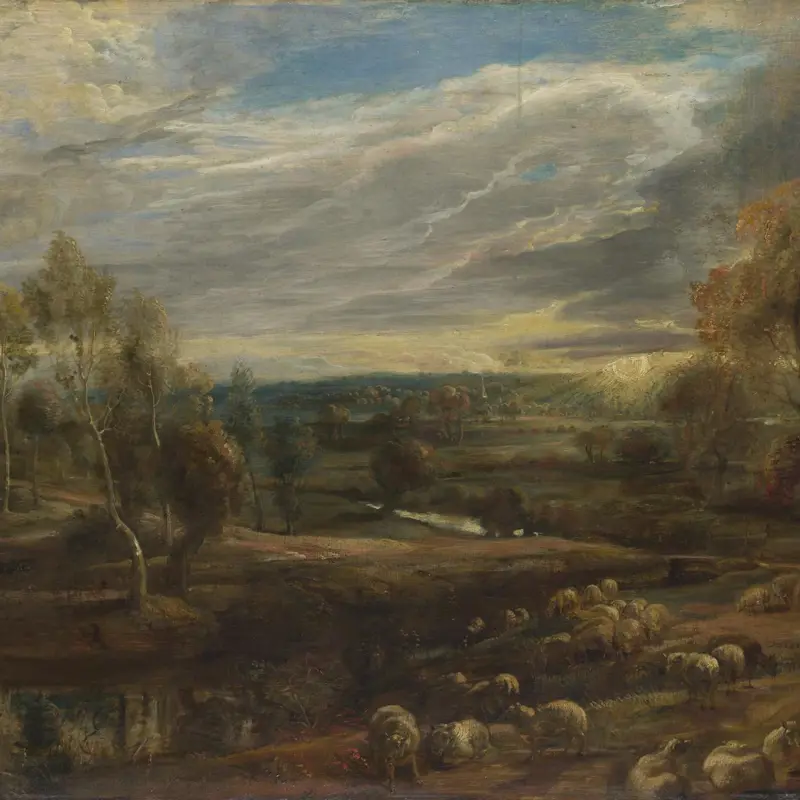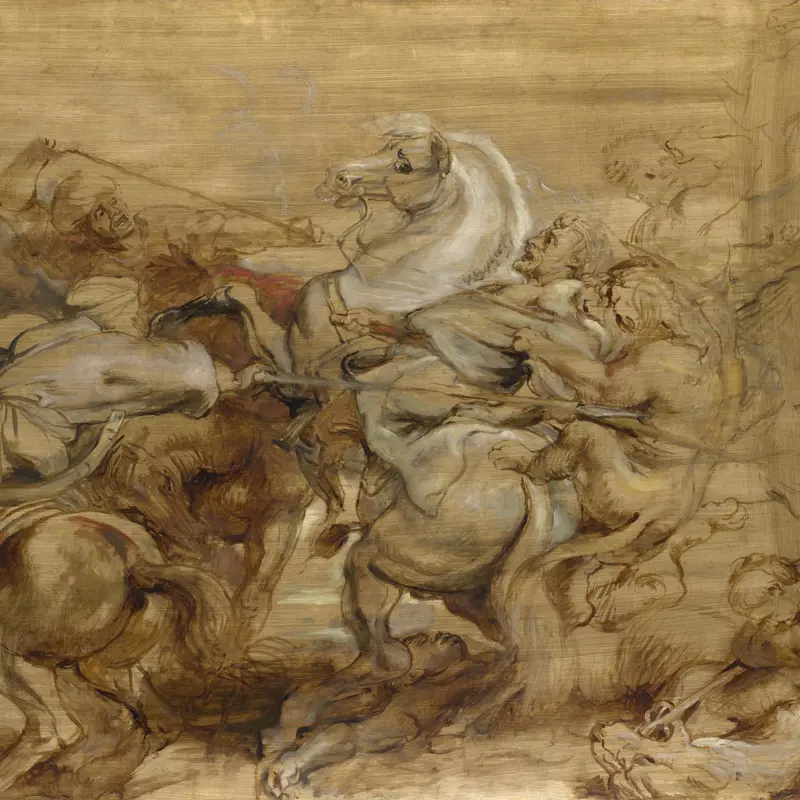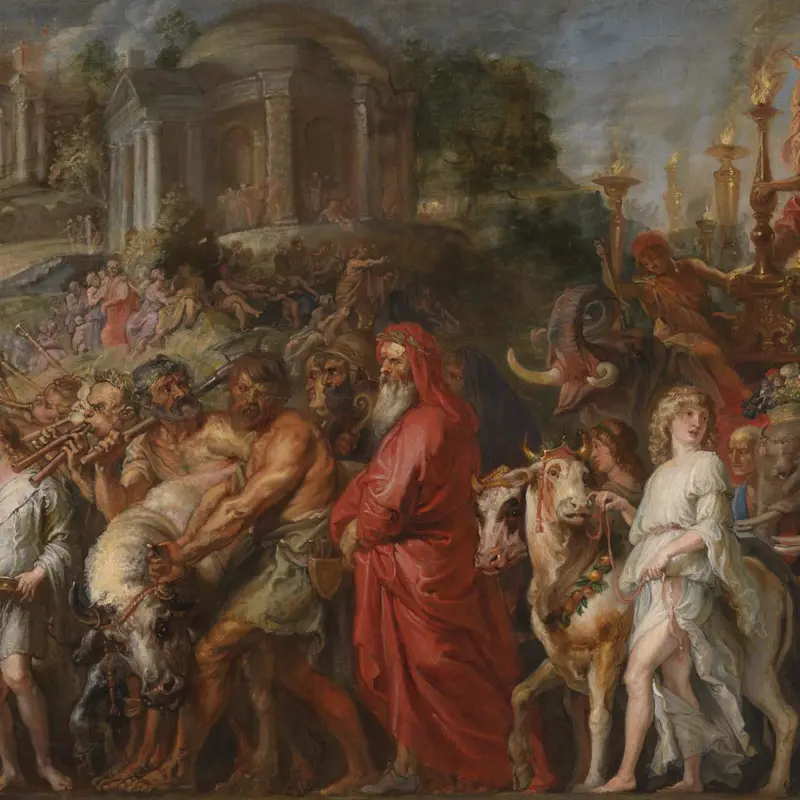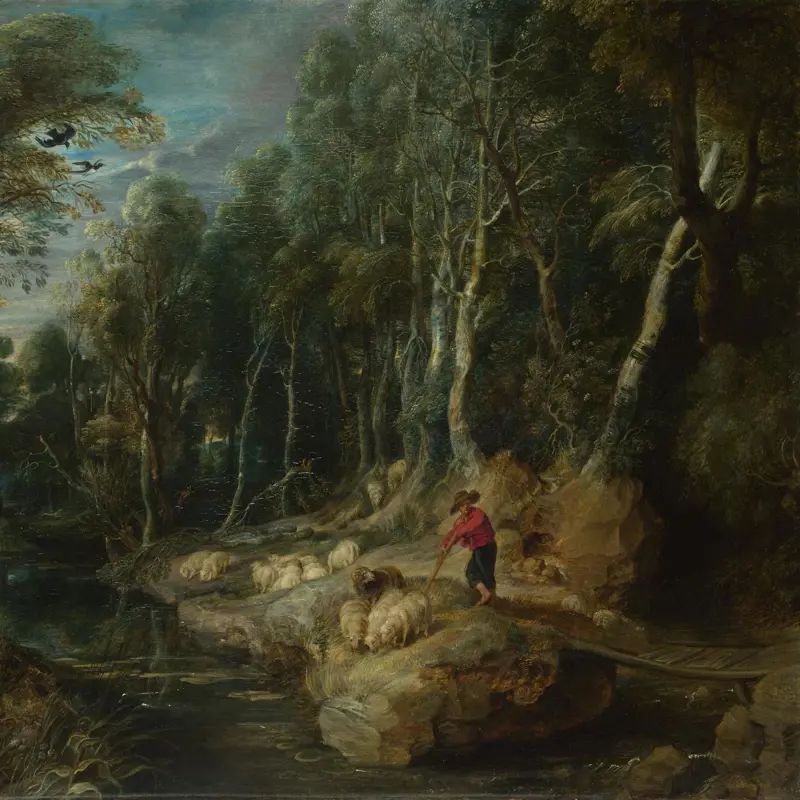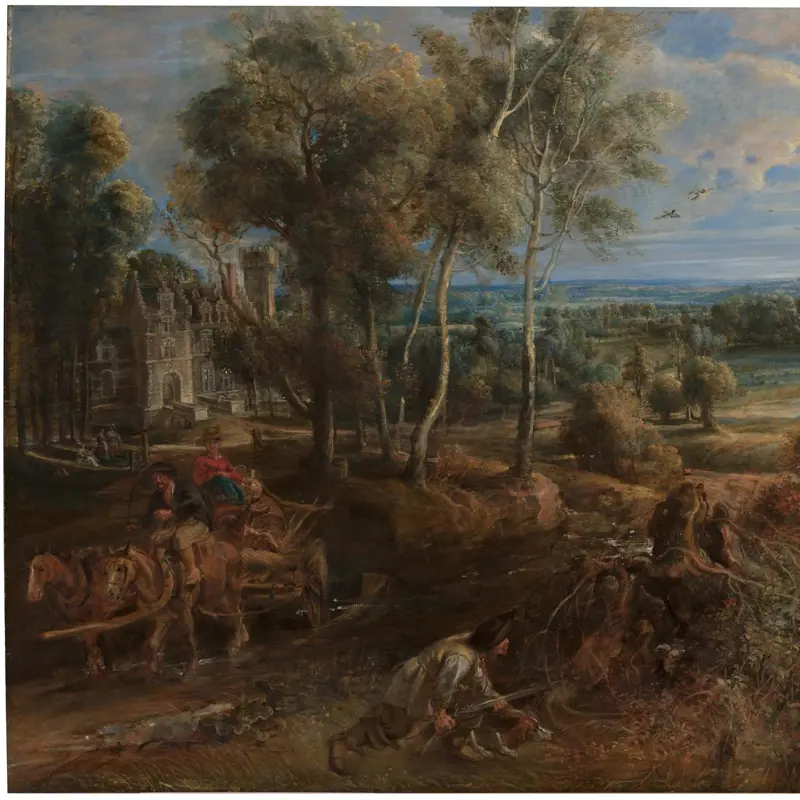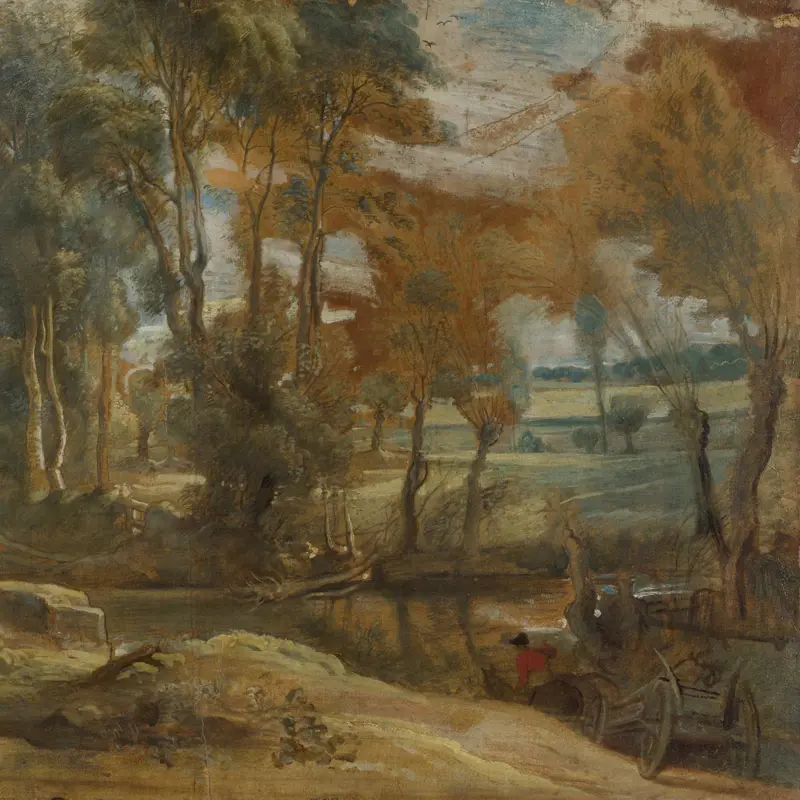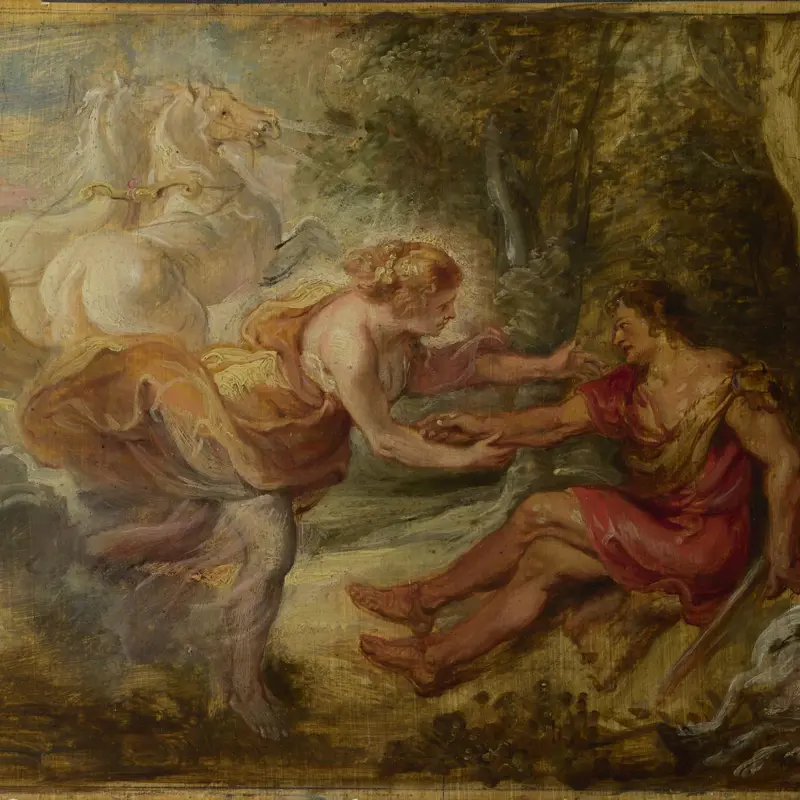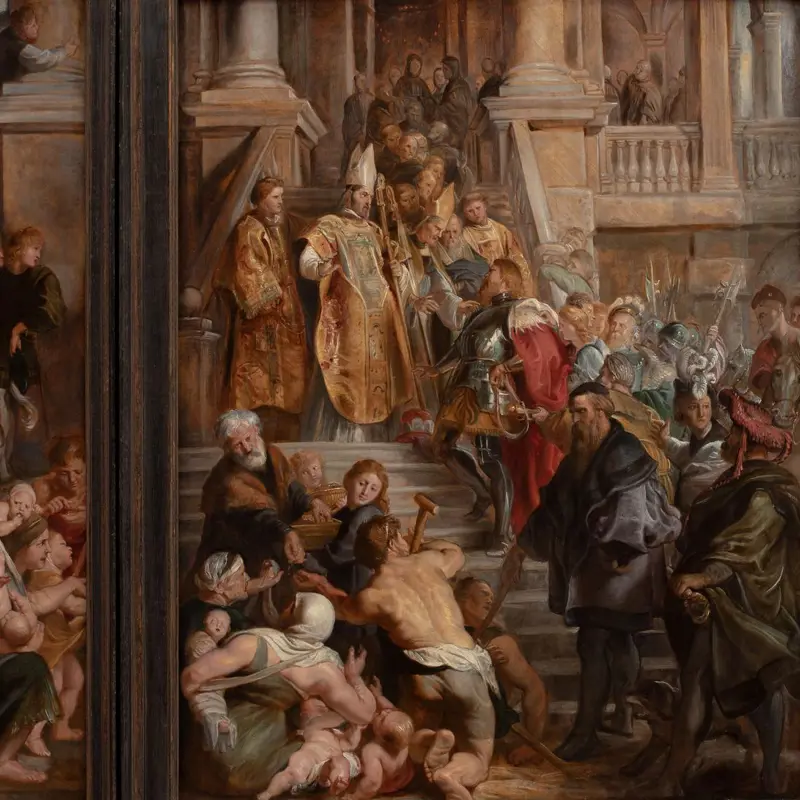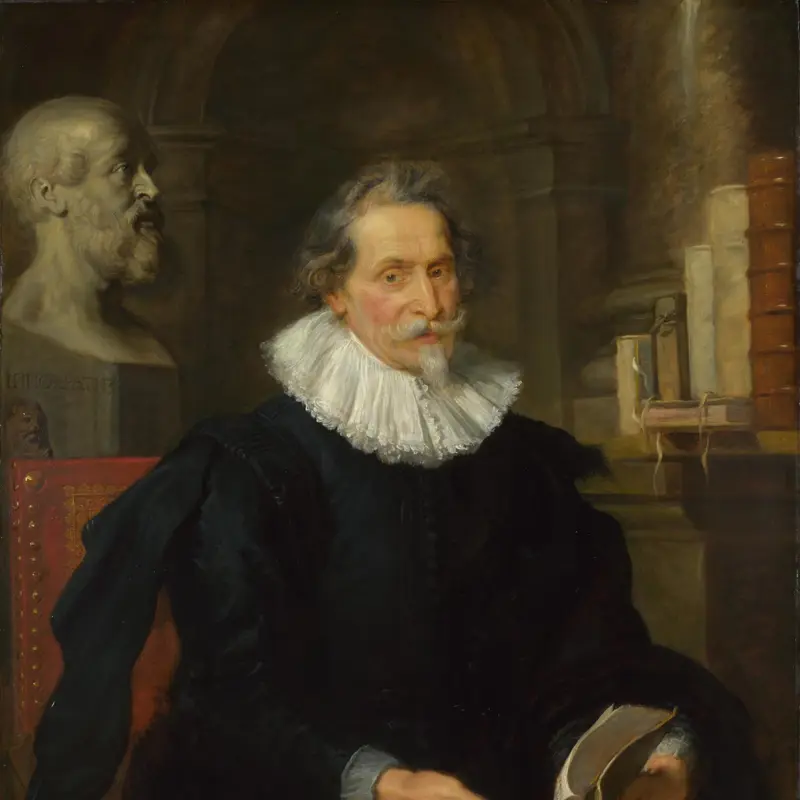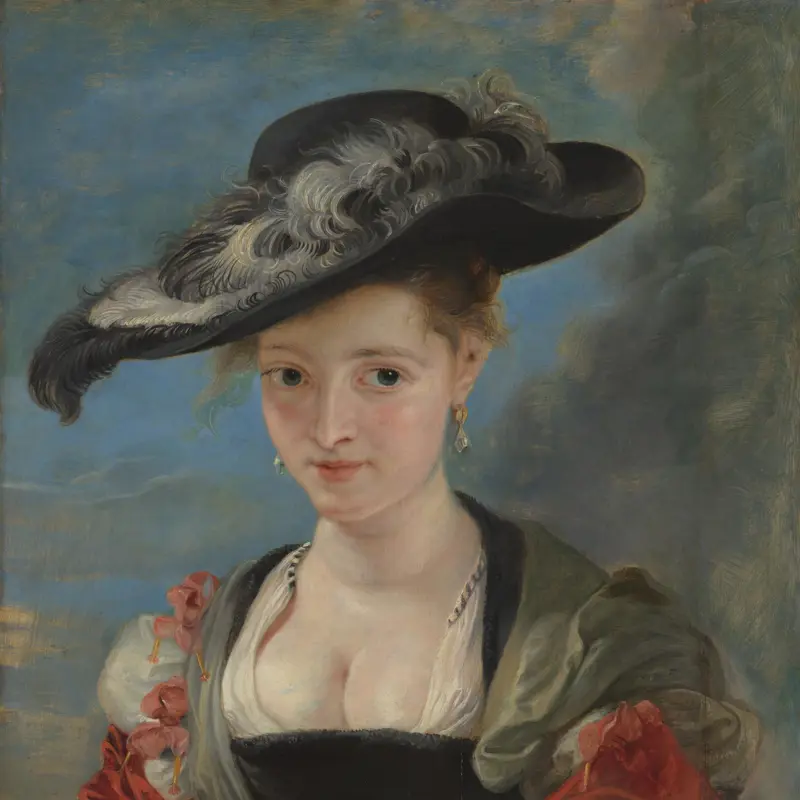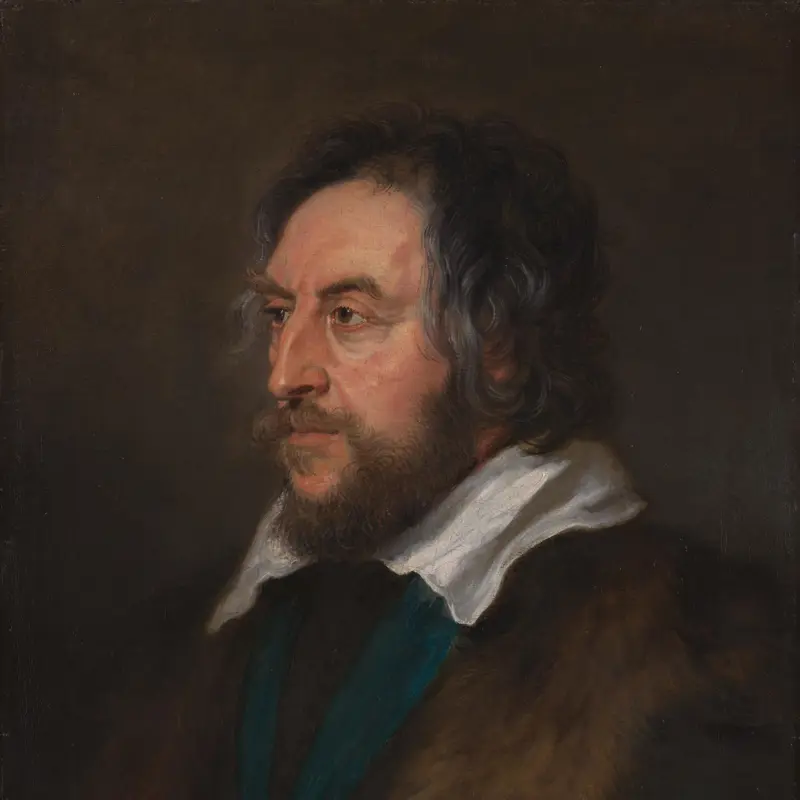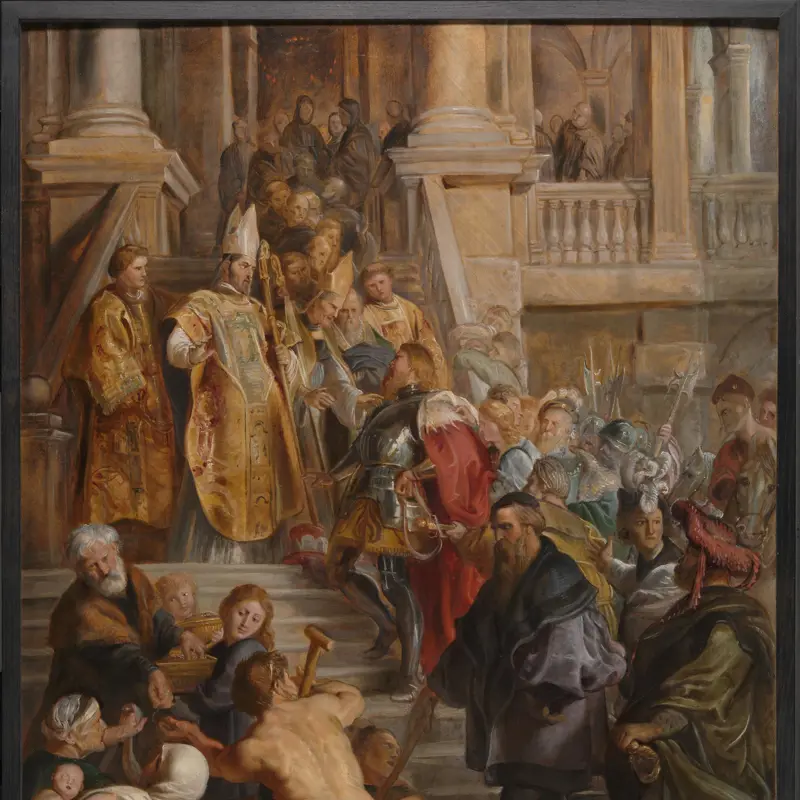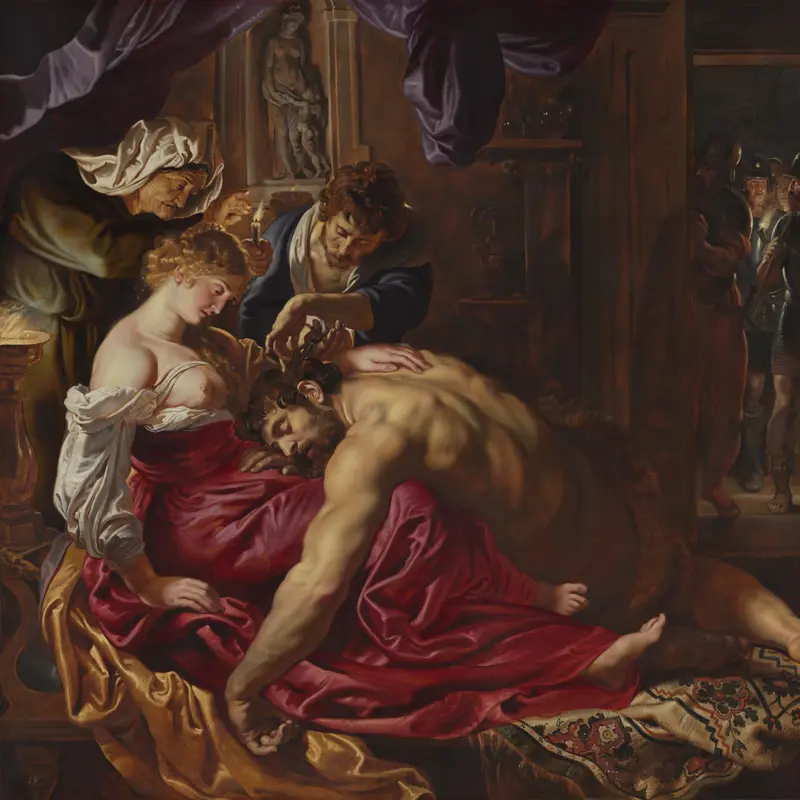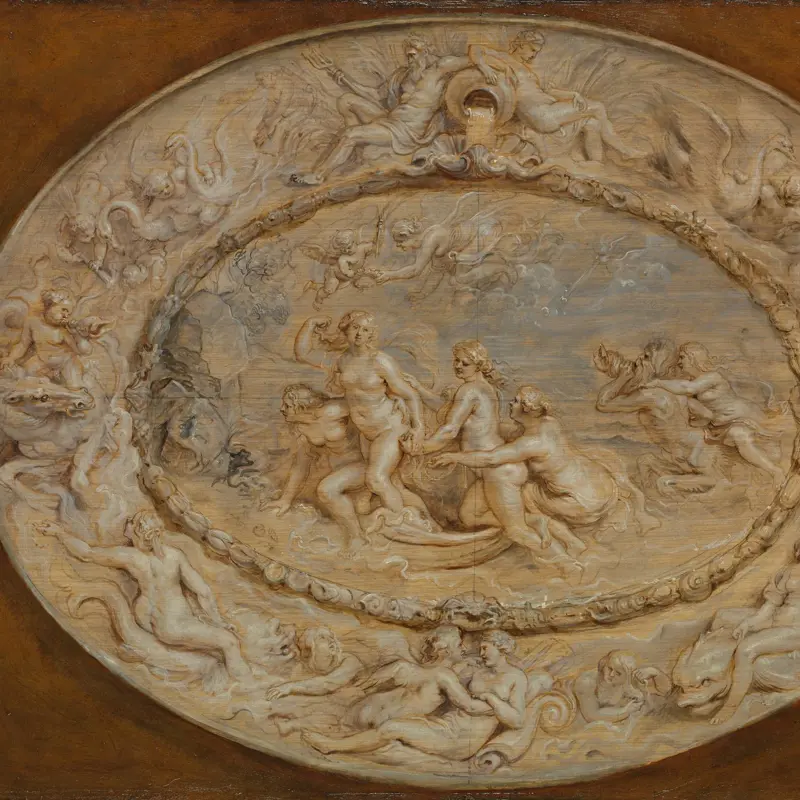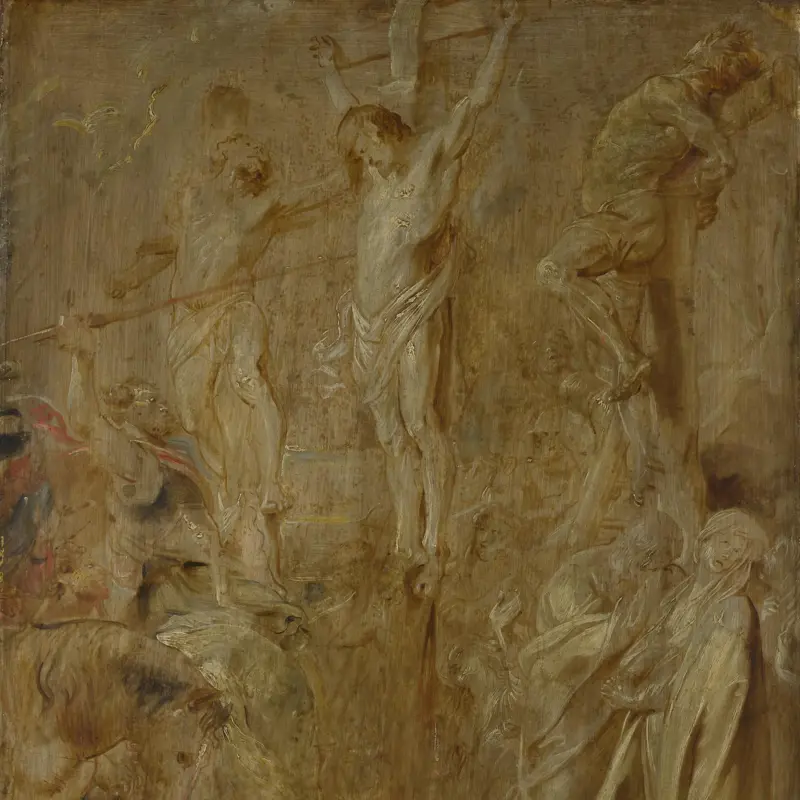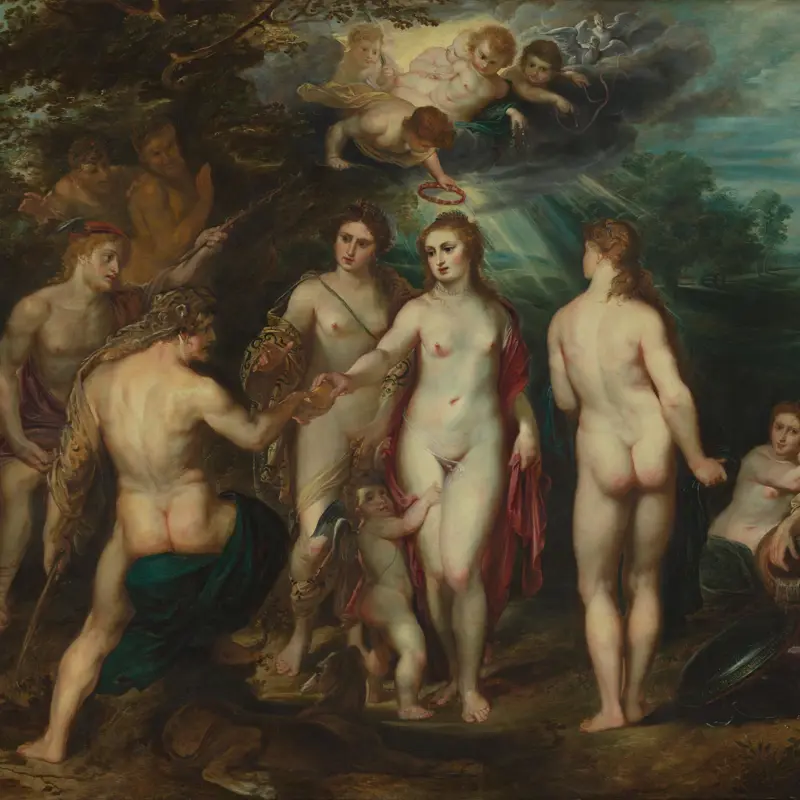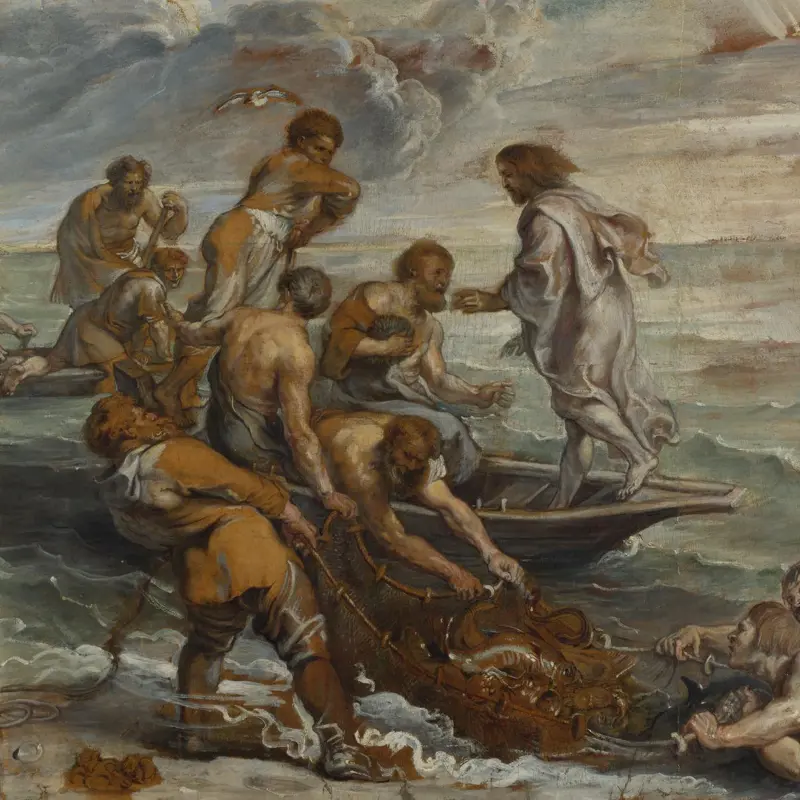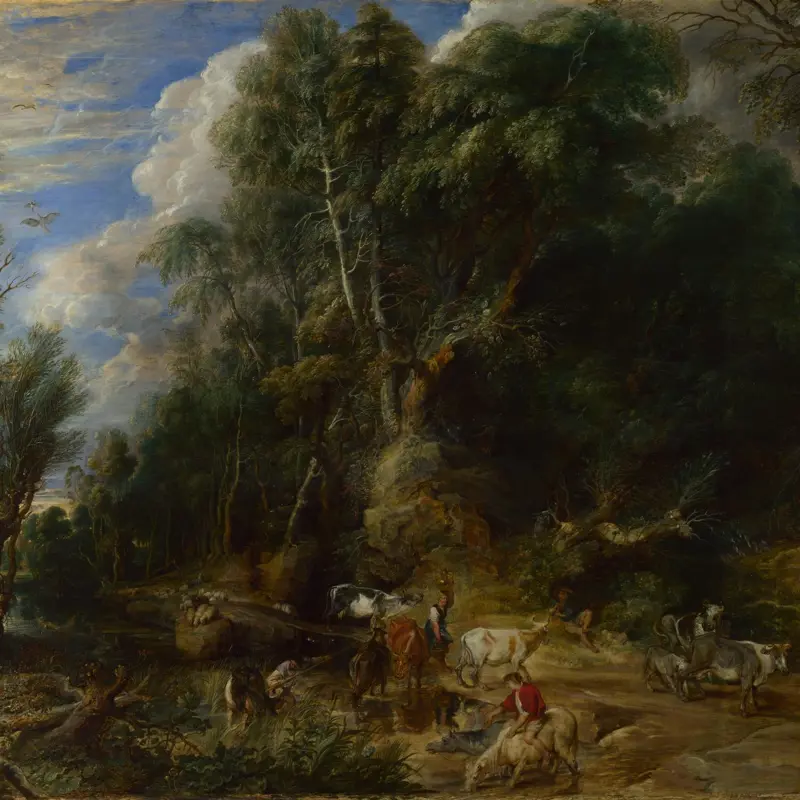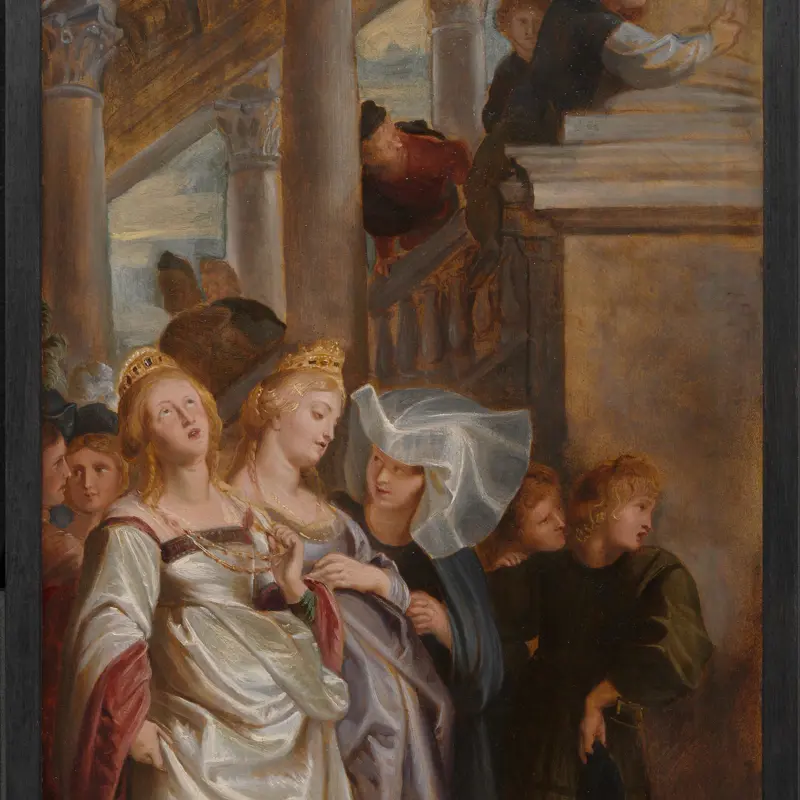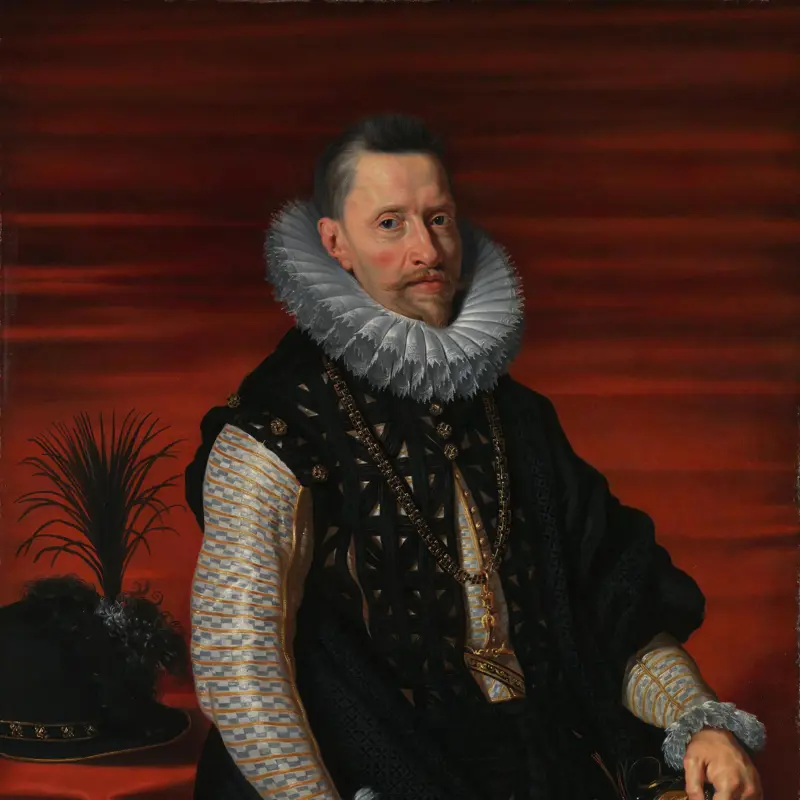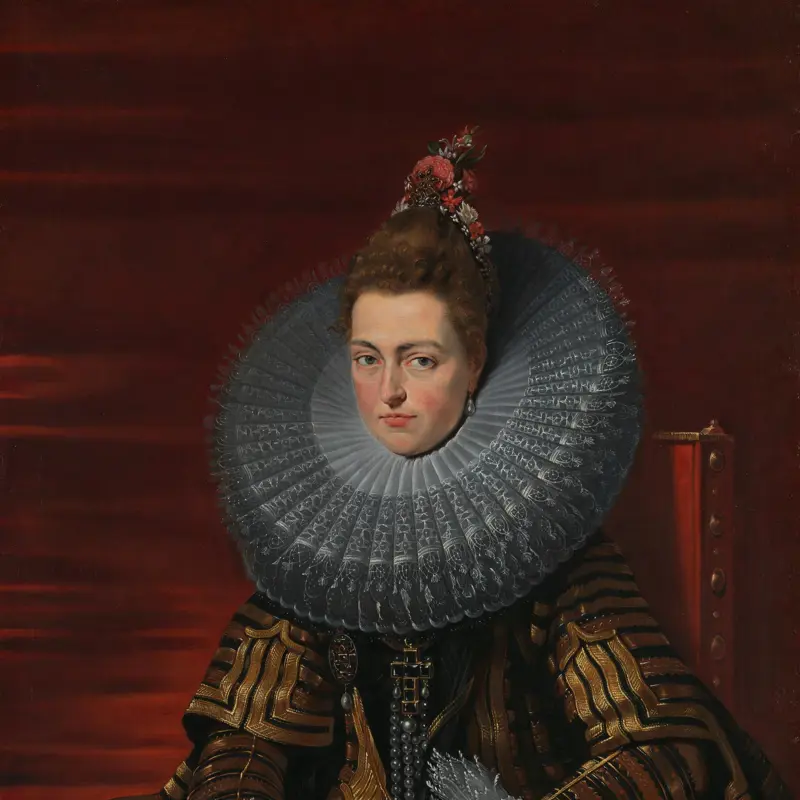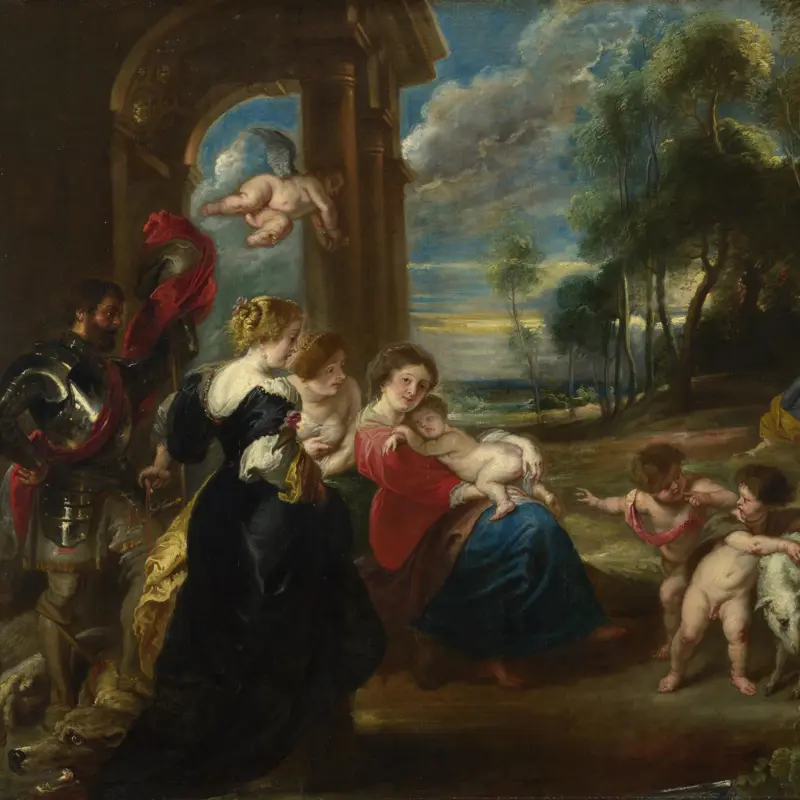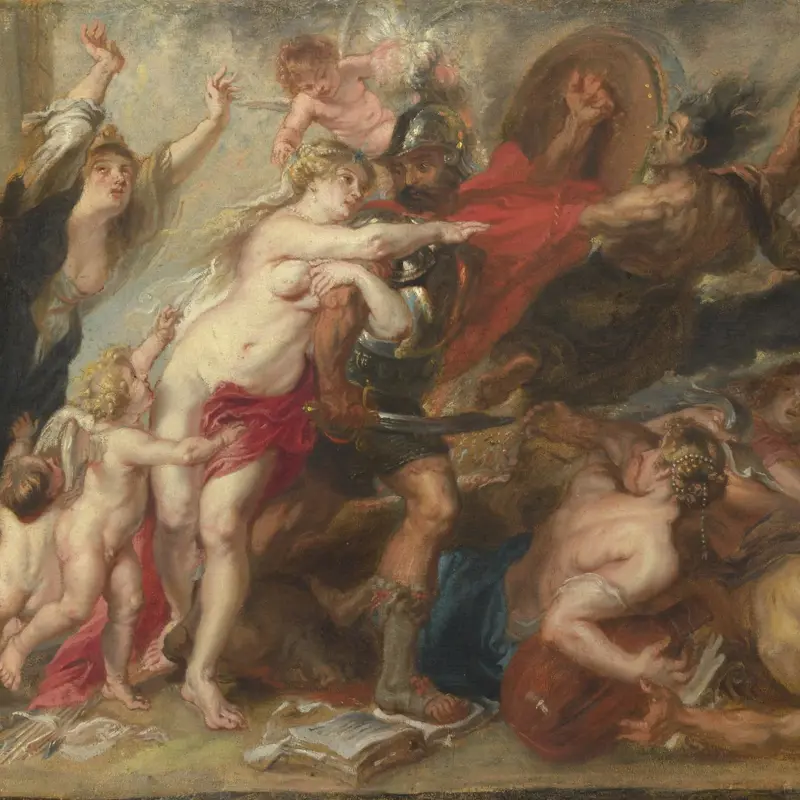Peter Paul Rubens, 'Minerva protects Pax from Mars ('Peace and War')', 1629-30
About the work
Overview
This picture was made for King Charles I of England and given to him by Rubens, who was acting as an envoy of Philip IV of Spain, in 1630. The two countries had been at war for five years and both sides were keen for a peace deal. The painting is an allegory, the figures representing different virtues and other abstract concepts, and there is a clear moral narrative.
Among the key figures, the woman in the centre represents both Pax (Peace) and Ceres, goddess of the earth, and she is sharing her bounty with a group of children in the foreground. These represent future generations, but are also portraits of the children of Sir Balthasar Gerbier, Rubens’s host. Just behind Pax, Minerva, goddess of wisdom, is protecting the group from Mars, god of war. The overall message is clear: rejecting war and embracing peace will bring prosperity and plenty. Rubens’s mission bore fruit: a peace treaty between England and Spain was signed in November 1630.
Key facts
Details
- Full title
- Minerva protects Pax from Mars ('Peace and War')
- Artist
- Peter Paul Rubens
- Artist dates
- 1577 - 1640
- Date made
- 1629-30
- Medium and support
- oil on canvas
- Dimensions
- 203.5 × 298 cm
- Acquisition credit
- Presented by the Duke of Sutherland, 1828
- Inventory number
- NG46
- Location
- Room 31
- Collection
- Main Collection
- Previous owners
- Frame
- 18th-century English Frame
Provenance
Additional information
Text extracted from the ‘Provenance’ section of the catalogue entry in Gregory Martin, ‘National Gallery Catalogues: The Flemish School: circa 1600–circa 1900’, London 1986; for further information, see the full catalogue entry.
Exhibition history
-
2017Rubens and RembrandtThe National Gallery (London)22 March 2017 - 6 August 2017
-
2018Charles I: King and CollectorRoyal Academy of Arts27 January 2018 - 15 April 2018
Bibliography
-
1757A. van der Doort, A Catalogue and Description of King Charles the First's Capital Collection of Pictures, Limnings, Statues, Bronzes, Medals, and Other Curiosities: Now Published from an Original Manuscript in the Ashmolean Museum at Oxford, the Whole Transcribed…by the Late Ingenious Mr Vertue, ed. G. Vertue, London 1757
-
1824W. Buchanan, Memoirs of Painting: With a Chronological History of the Importation of Pictures by the Great Masters into England Since the French Revolution, London 1824
-
1829
J. Smith, A Catalogue Raisonné of the Works of the Most Eminent Dutch, Flemish, and French Painters: In Which is Included a Short Biographical Notice of the Artists, with a Copious Description of Their Principal Pictures […], 9 vols, London 1829-1842
-
1847W. Coningham, The Picture Cleaning in the National Gallery, with Some Observations on the Royal Academy, London 1847
-
1886M. Rooses, L'œuvre de P. P. Rubens: Histoire et description de ses tableaux et dessins, 5 vols, Antwerp 1886-92
-
1897M. Rooses, 'L'Œuvre de Rubens: Addenda', Rubens-Bulletijn, V, 1897, pp. 69-111
-
1921R. Oldenbourg and A. Rosenberg, P. P. Rubens. Klassiker der Kunst in Gesamtausgaben, Stuttgart 1921
-
1967S. Alpers, 'Manner and Meaning in Some Rubens Mythologies', Journal of the Warburg and Courtauld Institutes, XXX, 1967, pp. 272-95
-
1970G. Martin, The Flemish School, circa 1600-circa 1900, London 1970
-
1973W. Stechow, 'Peter Paul Rubens's Deborah Kip, Wife of Sir Balthasar Gerbier, and Her Children', Studies in the History of Art, V, 1973
-
1974R. Baumstark, 'Ikonographische Studien zu Rubens Kriegs- und Friedensallegorien', Aachener Kunstblätter, XLV, 1974, pp. 125-234
-
1979A. Braham, Rubens, Themes and Painters in the National Gallery 8, London 1979
-
1979K. Downes, 'Rubens's "Peace and War" at the National Gallery', The Burlington Magazine, CXXI/915, 1979, pp. 397-8
-
1979C. Brown, 'Peace and War' Minerva Protects Pax from Mars (exh. cat. The National Gallery, 21 February - 29 April 1979), London 1979
-
1980A. Hughes, 'Naming the Unnameable: An Iconographical Problem in Rubens's Peace and War', The Burlington Magazine, CXXII/924, 1980, pp. 157-65
-
1983W.H. Wilson and W. McFarland (eds), Papers Presented at the International Rubens Symposium April 14-16, 1982, the John and Mable Ringling Museum of Art, Sarasota 1983
-
1984S. Keck, 'Some Picture Cleaning Controversies: Past and Present', Journal of the American Institute for Conservation, XXIII/2, 1984, pp. 73-87
-
1985T.K. Rabb, 'Artists and Warfare: A Study of Changing Values in Seventeenth-Century Europe', Transactions of the American Philosophical Society, LXXV/6, 1985, pp. 79-106
-
1986Martin, Gregory, National Gallery Catalogues: The Flemish School, circa 1600 - circa 1900, London 1986
-
1987C. White, Peter Paul Rubens: Man and Artist, New Haven 1987
-
1989M. Jaffé, Rubens: Catalogo completo, Milan 1989
-
1989A. MacGregor (ed.), The Late King's Goods: Collections, Possessions and Patronage of Charles I in the Light of the Commonwealth Sale Inventories, London 1989
-
1989A.J. Loomie, 'New Light on the Spanish Ambassador's Purchases from Charles I's Collection, 1649-53', Journal of the Warburg and Courtauld Institutes, LII, 1989, pp. 257-67
-
1989L. Rosenthal, 'The Parens Patriae: Familial Imagery in Rubens's Minerva Protects Pax from Mars', Art History, XII/1, 1989, pp. 20-38
-
1993L. Rosenthal, 'Manhood and Statehood: Rubens's Construction of Heroic Virtue', Oxford Art Journal, XVI/1, 1993, pp. 92-111
-
1995S. Alpers, The Making of Rubens, New Haven 1995
-
1995J. Brown, Kings and Connoisseurs: Collecting Art in Seventeenth-Century Europe, New Haven 1995
-
1996O. von Simson, Peter Paul Rubens (1577-1640): Humanist, Maler und Diplomat, Mainz 1996
-
1996J. Kirby and R. White, 'The Identification of Red Lake Pigment Dyestuffs and a Discussion of their Use', National Gallery Technical Bulletin, XVII, 1996, pp. 56-80
-
1997E. McGrath, Rubens: Subjects from History, ed. A. Balis, London 1997
-
1997P. Cherry and M.B. Burke, Collections of Paintings in Madrid, 1601-1755, vol. 1, ed. M.L. Gilbert, Los Angeles 1997
-
1998H.-M. Kaulbach, 'Peter Paul Rubens: Diplomat und Maler des Friedens', in D. Müller Hofstede (ed.), 1648: Krieg und Frieden in Europa. Textband II: Kunst und Kultur, Münster 1998, pp. 565-74
-
1998H. Vlieghe, B. Descheemaeker and I. Wouters, 'Traum und Beschwörung: über Allegorien von Krieg und Frieden in den südlichen Niederlanden nach Rubens', in D. Müller Hofstede (ed.), 1648: Krieg und Frieden in Europa. Textband II: Kunst und Kultur, Münster 1998, pp. 575-85
-
1999A. Roy, 'Rubens's "Peace and War"', National Gallery Technical Bulletin, XX, 1999, pp. 89-95
-
1999L. Rosenthal, 'Paternal and Painterly Authority in Rubens's Self-Portrait with his Wife, Helena Fourment and their Son, Peter Paul', Dutch Crossing: A Journal of Low Country Studies, XXIII/2, 1999, pp. 131-62
-
2001
C. Baker and T. Henry, The National Gallery: Complete Illustrated Catalogue, London 2001
-
2002J. Brown and J. Elliott, The Sale of the Century: Artistic Relations between Spain and Great Britain, 1604-1655, New Haven 2002
-
2004A. Brejon de Lavergnée, Rubens (exh. cat., Palais des Beaux-Arts, Lille), Paris 2004
-
2004F. Donovan, Rubens and England, New Haven 2004
-
2004U. Heinen, 'Rubens' Pictorial Diplomacy at War (1637-1638)', Nederlands Kunsthistorisch Jaarboek, LV, 2004, pp. 197-225
-
2004A. Brejon de Lavergnée, Rubens (exh. cat. Palais des Beaux-Arts, Lille, 6 March - 14 June 2004), Lille 2004
-
2005A.-M. Logan, with M.C. Plomp, Peter Paul Rubens: The Drawings (exh. cat., The Metropolitan Museum of Art, New York), New Haven 2005
-
2005L. Rosenthal, Gender, Politics, and Allegory in the Art of Rubens, Cambridge 2005
-
2005A.-M. Logan and M.C. Plomp, Peter Paul Rubens: The Drawings, (exh. cat. Metropolitan Museum of Art, 15 January - 3 April 2005), New York 2005
-
2007A. Anselmi, 'Il VII Marchese del Carpio da Roma a Napoli', Paragone, LVIII/683, 2007, pp. 80-109
-
2008J. Brotton and D. McGrath, 'The Spanish Acquisition of King Charles I's Art Collection', Journal of the History of Collections, XX/1, 2008, pp. 1-16
-
2011G. Martin, Rubens in London: Art and Diplomacy, London 2011
About this record
If you know more about this work or have spotted an error, please contact us. Please note that exhibition histories are listed from 2009 onwards. Bibliographies may not be complete; more comprehensive information is available in the National Gallery Library.

